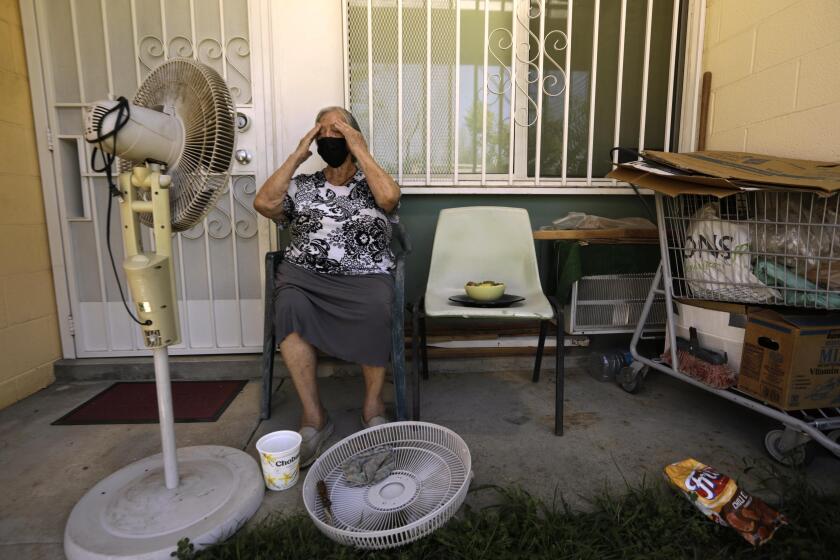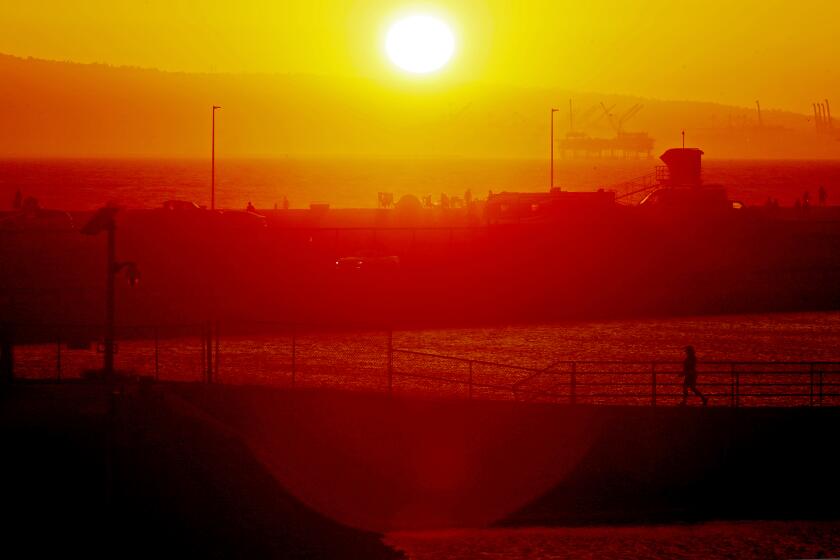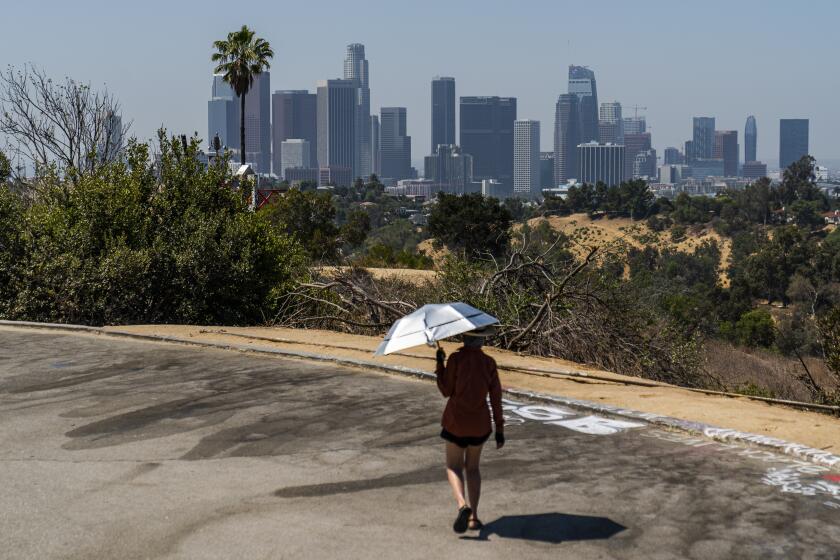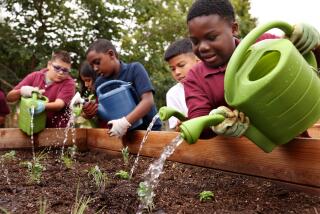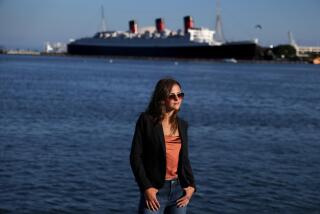Playground asphalt sizzles to 145 degrees in extreme heat waves. Parents demand school shade
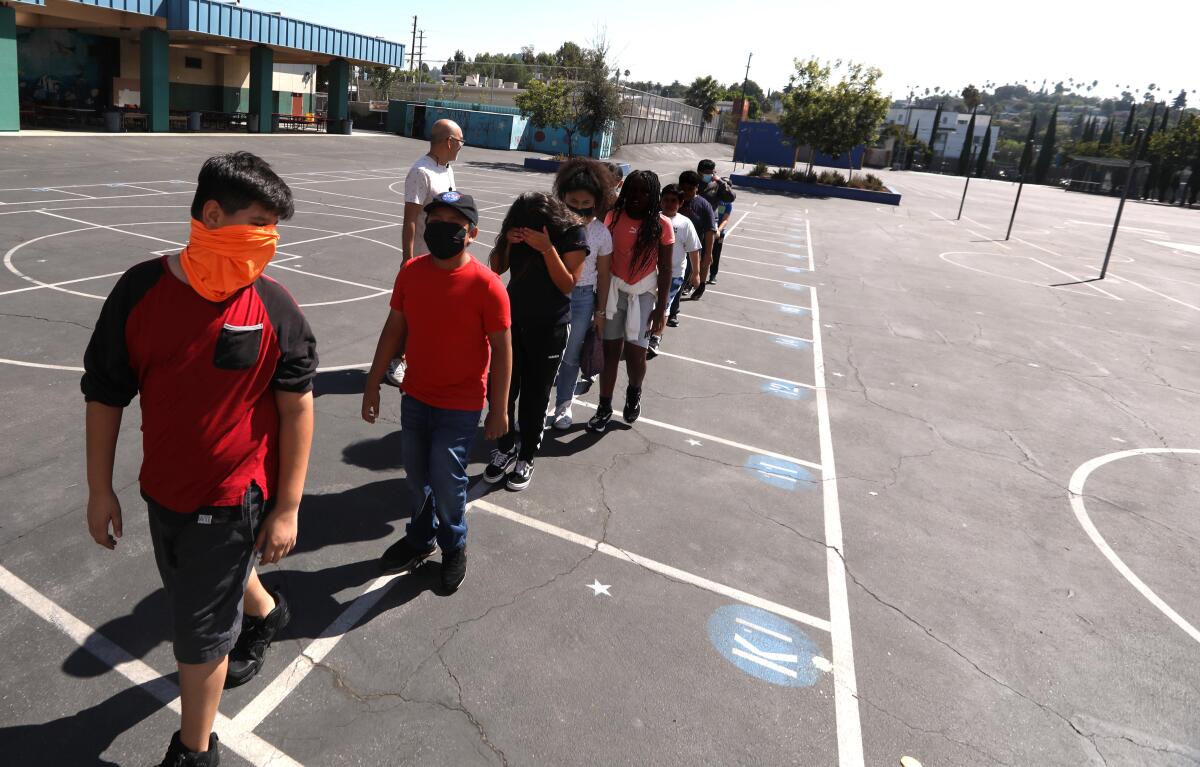
Sweat streamed down the faces of children during 10 a.m. recess Wednesday at Lockwood Elementary. Boys’ cheeks flushed red as they played kickball. Girls found a sliver of shade beneath a handball wall to jump rope. With morning temperatures soaring into the 90s, this would be their last outdoor foray on their asphalt playground in East Hollywood.
It was Day 1 of what is forecast to be the longest and hottest heatwave this year, and the Lockwood asphalt would radiate too much heat for them to play safely. But such is the sizzling heat problem at this campus, which holds the No. 1 ranking on L.A. Unified’ s “Greening Index,” a long list of schools in desperate need of green space and shade.
At Lockwood there is 162,059 square feet of hardscape, and only 1,049 of green space — and a few spindly trees in planter boxes.
“At least cover the playground area, like the swing set. My daughter can’t touch them because she gets burned,” said Reyna Ramos, as she picked up her child Wednesday. Ramos was anxious to get the 8-year-old home, where she would cool off with a glass of water, sit down and just breathe.
“The school needs places for kids to hang out during extreme heat,” Ramos said.
As extreme heat days spurred by climate change increase, as schools begin in mid-August, and as educators stress the importance of outside play and exercise, hot schools are prompting parent demands to “de-asphalt” campuses like Lockwood.
They complain greening projects are woefully behind and urgent action is needed to protect children from heat dangers. Parents and environmental advocates are calling for an easier, more equitable process to speed up the pace of projects.
More than 600 schools are listed on the L.A. Unified “Greening Index,” which ranks campuses in order of the most asphalt and least amount of green space. Access to neighborhood parks is also figured into the rankings. Most of the 150 schools in “very high need” are in South and East Los Angeles, where park space is scarce and academic achievement gaps are widest.
Paved surfaces, tree cover, and home construction quality can make the difference between heat waves being an inconvenience or a threat to your life.
But making improvements is not as simple as going down the list in order of need. Parents say building green projects can be a long, bureaucratic and often frustrating process. And individual school communities have had to lobby for improvements.
On Tuesday, school board President Kelly Gonez, who represents a largely east San Fernando Valley area where temperatures soar, introduced a resolution to establish a minimum standard of 30% green space on every campus and to devote additional bond dollars to ensure the requirement is achieved districtwide by 2032.
“We urgently need a systemwide solution to expand green space, particularly for low-income communities of color that are most likely to be harmed by climate change and extreme heat,” Gonez said. “This is an opportunity for L.A. Unified to correct those inequities on a system level and to expand green spaces where the problem is most urgent.”
According to the district’s Greening Index, only 16% of campuses meet the recommended threshold of green space and at 235 elementary schools, 10% or less of their campus is green space.
The danger of asphalt and hardscape school grounds is real.
The high-pressure system over most of California is expected to bring record-breaking temperatures, part of a “self-perpetuating” system that is becoming more extreme as climate change worsens.
Researchers have found that schoolyards are often the hottest locations in communities due to the large swaths of asphalt.
Schools are often designed with efficiency in mind, which has created a “worst-case scenario” for children, said V. Kelly Turner, associate professor of urban planning and geography at UCLA’s Luskin School of Public Affairs. They’re flat, one-story campuses that offer little shade from buildings or trees. On a 93-degree day in the San Fernando Valley, researchers have recorded school asphalt temperatures of 145 degrees.
Federal guidelines consider extreme heat to be 90 degrees and above. School staff in L.A. — and at districts throughout the region — take precautions during the kind of heatwave that began Wednesday: keeping students to air-conditioned rooms, cutting recess short, moving athletic practices to morning hours and canceling games. Los Angeles Unified School District guidelines recommend decreased physical activity and encouraging students to bring water bottles and take frequent water breaks.
Krisztina Tokes, deputy chief facilities executive for LAUSD, explained there are generally three ways to start a greening project: through partnerships with nonprofits or government entities that help identify school sites and assist with funding, through specially designated capital bond fund projects, and through grassroots organizing.
The projects can take various forms and don’t always involve shade — but usually remove asphalt. A green space can be a garden, full of native plants that serve as a rest area and educational tool; a drought-friendly stormwater runoff project that captures rainwater; an outdoor space with wooden stumps and shade trees.
Experts remind Southern California residents to stay hydrated, stay out of the direct sun and shelter in air conditioned buildings, if possible.
“No one is going to build a super dome over the play yard,” said Mark Hovatter, the district’s chief facilities executive. “Kids are going to be in the sun when they play outside. We need to try to do something that still allows for healthy outdoor activities.”
To address urgent heat concerns, the district is considering installing misting stations and is in the process of adding water refilling stations in schools. Strict safety standards prevent schools from erecting tents or canopies as an immediate shade solution, as some parents have demanded.
Parents and environmental activists want the district to move more aggressively and complain this process places the burden on principals and families.
As the heat bore down this week, parents asked for donations of cold bottled water because school fountains are hot.
“Science tells us that our days will only get hotter,” said Rudy Gonzalves, director of the Los Angeles Alliance for a New Economy’s education campaign. “LAUSD cannot fight the climate crisis with calls for public donations and bake sales. This crisis demands a comprehensive approach that involves parents, students, educators and the community at large.”
For LAUSD’s children, more shade means more playtime.
Lilian, 8, plans her outside activities according to the shade available at her Woodland Hills school. Sometimes it’s a play structure that has a bit of shade, sometimes it’s the handball wall.
Other hot areas are simply off-limits; the asphalt burns her hand if she touches it.
“I think my school is amazing, even though I’m burning up my own skin,” she said. “I wish it had a bit more shade.”
More to Read
Sign up for Essential California
The most important California stories and recommendations in your inbox every morning.
You may occasionally receive promotional content from the Los Angeles Times.
